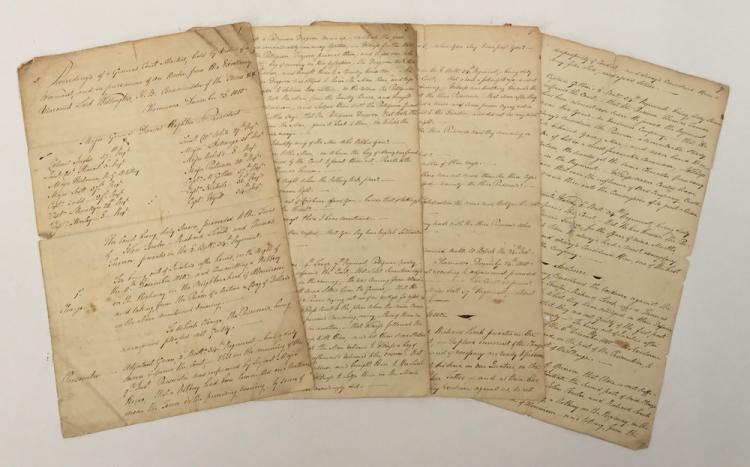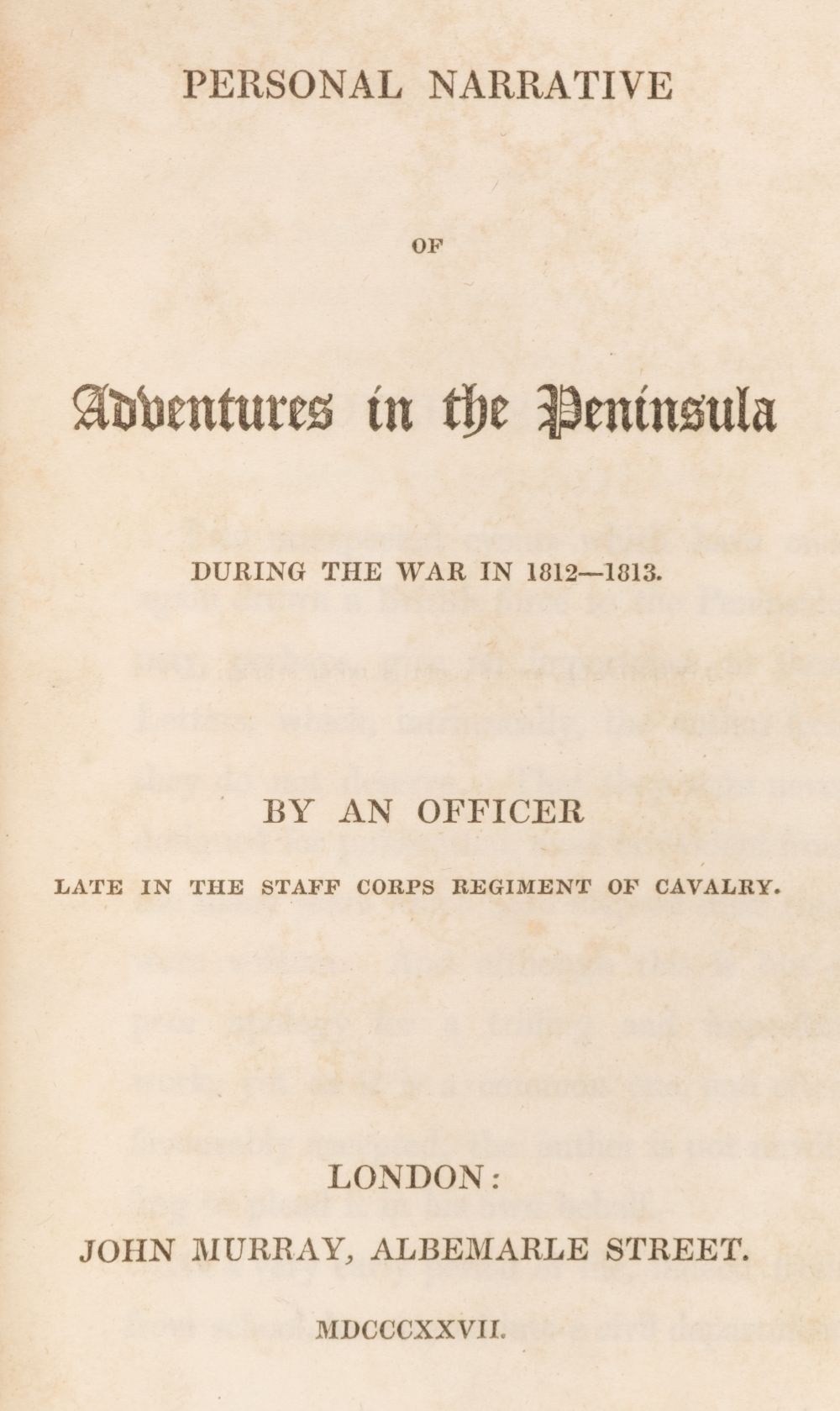A scarce Peninsula War and Waterloo pair awarded to Lieutenant Colonel James Sinclair Royal Foot Artillery, Commanding Sinclair’s Brigade at the Battle of Waterloo Military General Service 1793-1814, 7 clasps, Corunna, Badajoz, Salamanca, Vittoria, Pyrenees, Nivelle, Nive (J. Sinclair, Lieut. R. Arty.); Waterloo 1815 (Capt., Royal Foot Artillery) fitted with original steel clip and ring suspension, the first good very fine, the second with contact marks, otherwise very fine (2) £1800-2200 Footnote Only four officers of the Royal Foot Artillery received both the Waterloo and Military General Service medal, this pair having the greatest number of clasps. Of the other recipients, Lieutenant Thomas Cater was not in action at Waterloo. James Sinclair was born in Doreay, Caithness-shire, and received a commission as a Second Lieutenant in the Royal Artillery on 9 June 1804, and appointed to the 3rd Battalion. He was promoted to First Lieutenant in November 1805, and took part in the expedition to Zealand (Copenhagen) in July to November 1807, under Lord Cathcart. By 1808 he was serving in Captain Wilmot’s company of the 3rd Battalion, which was armed with light 6-pounders, and in May embarked for Sweden as part of Sir John Moore’s expedition, but did not land; the company returned to Britain in July but immediately proceeded to the Peninsula, arriving in August 1808. Sinclair served with Wilmot in the campaign and battle of Corunna and then returned to accompany the disease-ridden expedition to Walcheren and the Scheldt, under Lord Chatham, from July to September 1809. During the Siege of Flushing in early August, a detachment of the Artillery under Wilmot unspiked ten 24-pounders and three howitzers in Fort Batz and, on the afternoon of 5th August, Wilmot’s men defended the fort successfully during a two-hour attack by 25 French brigs. Chatham later reported, ‘It is impossible for me to do sufficient justice to the distinguished conduct of the officers and men of the Royal Artillery, under the able direction and animating example of Brigadier-General M’Leod.’ Upon returning from Holland, Sinclair was transferred to the 5th Battalion and received training in the use of Congreve rockets. His statement of service notes that in February 1811 he was sent to Portugal ‘in charge of Rockets.’ He participated in the assault of Badajoz (6 April 1812) in Walker’s Brigade of the 5th Division, at the battle of Salamanca, and in the action at Villa Muriel on 25th October 1812. In 1813 Sinclair was appointed ‘Adjutant of Artillery in Lord Hill’s Corps’, in which capacity he served at the battle of Vittoria, the action at Maya, and the subsequent actions in the Pyrenees. Shortly afterwards, he relinquished his position as Adjutant of Artillery upon his appointment as aide-de-camp to Major-General Andrew Hay who commanded a Brigade in the 5th Division. Hay did not enjoy a high reputation in the army, being described by a fellow General Officer as ‘A fool and I verily believe, with many others on my side, an arrant coward. That he is a paltry, plundering old wretch is established beyond doubt. That he is no Officer is as clear, and that he wants spirit is firmly believed, ergo, he ought not to be a General...’ As ADC to Hay, Sinclair participated in the Passage of the Bidassoa, the battles of Nivelle and Nive and, on 14th April 1814, the sortie from Bayonne. On this latter occasion Major-General Hay was killed whilst organizing defences around the village church at St Etienne. Having been promoted to Second Captain in February 1814, Sinclair commanded one of the five ‘Field Brigades’ of the Royal Artillery at the battle of Waterloo, his battery having been previously commanded by Captain Frederick Gordon, who was at that time in Canada. John A. Wilson a First Lieutenant under Sinclair, described the activities of Sinclair’s battery at Waterloo: ‘At the commencement of the action Captain Sinclair’s Brigade was posted near a windmill in a field on
A scarce Peninsula War and Waterloo pair awarded to Lieutenant Colonel James Sinclair Royal Foot Artillery, Commanding Sinclair’s Brigade at the Battle of Waterloo Military General Service 1793-1814, 7 clasps, Corunna, Badajoz, Salamanca, Vittoria, Pyrenees, Nivelle, Nive (J. Sinclair, Lieut. R. Arty.); Waterloo 1815 (Capt., Royal Foot Artillery) fitted with original steel clip and ring suspension, the first good very fine, the second with contact marks, otherwise very fine (2) £1800-2200 Footnote Only four officers of the Royal Foot Artillery received both the Waterloo and Military General Service medal, this pair having the greatest number of clasps. Of the other recipients, Lieutenant Thomas Cater was not in action at Waterloo. James Sinclair was born in Doreay, Caithness-shire, and received a commission as a Second Lieutenant in the Royal Artillery on 9 June 1804, and appointed to the 3rd Battalion. He was promoted to First Lieutenant in November 1805, and took part in the expedition to Zealand (Copenhagen) in July to November 1807, under Lord Cathcart. By 1808 he was serving in Captain Wilmot’s company of the 3rd Battalion, which was armed with light 6-pounders, and in May embarked for Sweden as part of Sir John Moore’s expedition, but did not land; the company returned to Britain in July but immediately proceeded to the Peninsula, arriving in August 1808. Sinclair served with Wilmot in the campaign and battle of Corunna and then returned to accompany the disease-ridden expedition to Walcheren and the Scheldt, under Lord Chatham, from July to September 1809. During the Siege of Flushing in early August, a detachment of the Artillery under Wilmot unspiked ten 24-pounders and three howitzers in Fort Batz and, on the afternoon of 5th August, Wilmot’s men defended the fort successfully during a two-hour attack by 25 French brigs. Chatham later reported, ‘It is impossible for me to do sufficient justice to the distinguished conduct of the officers and men of the Royal Artillery, under the able direction and animating example of Brigadier-General M’Leod.’ Upon returning from Holland, Sinclair was transferred to the 5th Battalion and received training in the use of Congreve rockets. His statement of service notes that in February 1811 he was sent to Portugal ‘in charge of Rockets.’ He participated in the assault of Badajoz (6 April 1812) in Walker’s Brigade of the 5th Division, at the battle of Salamanca, and in the action at Villa Muriel on 25th October 1812. In 1813 Sinclair was appointed ‘Adjutant of Artillery in Lord Hill’s Corps’, in which capacity he served at the battle of Vittoria, the action at Maya, and the subsequent actions in the Pyrenees. Shortly afterwards, he relinquished his position as Adjutant of Artillery upon his appointment as aide-de-camp to Major-General Andrew Hay who commanded a Brigade in the 5th Division. Hay did not enjoy a high reputation in the army, being described by a fellow General Officer as ‘A fool and I verily believe, with many others on my side, an arrant coward. That he is a paltry, plundering old wretch is established beyond doubt. That he is no Officer is as clear, and that he wants spirit is firmly believed, ergo, he ought not to be a General...’ As ADC to Hay, Sinclair participated in the Passage of the Bidassoa, the battles of Nivelle and Nive and, on 14th April 1814, the sortie from Bayonne. On this latter occasion Major-General Hay was killed whilst organizing defences around the village church at St Etienne. Having been promoted to Second Captain in February 1814, Sinclair commanded one of the five ‘Field Brigades’ of the Royal Artillery at the battle of Waterloo, his battery having been previously commanded by Captain Frederick Gordon, who was at that time in Canada. John A. Wilson a First Lieutenant under Sinclair, described the activities of Sinclair’s battery at Waterloo: ‘At the commencement of the action Captain Sinclair’s Brigade was posted near a windmill in a field on





/103820/Internet%20Image%201.jpg)


/119840/Internet%20Image%201.jpg)






Try LotSearch and its premium features for 7 days - without any costs!
Be notified automatically about new items in upcoming auctions.
Create an alert